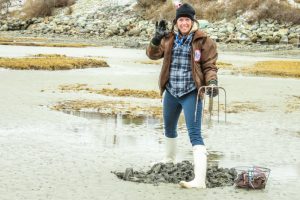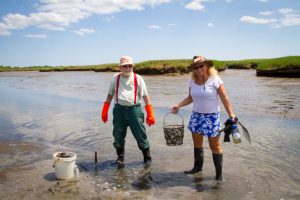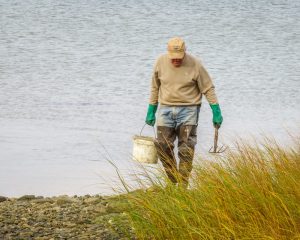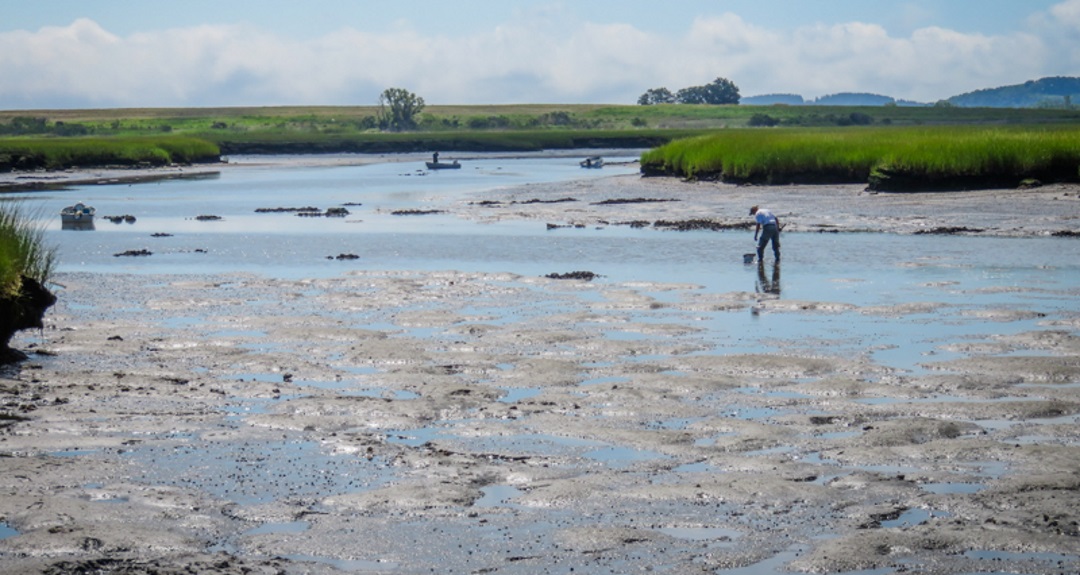Water Closet for February 16, 2018
[pullquote]”Tom had always impressed them with his disciplined style. Wearing hip boots, he kneeled on the flat and thoroughly got all of legal size from the upturned clogs of mud”[/pullquote]
On January 11th Stream Teamer Thomas Jacques died. He didn’t show up at Freddie’s in Middleton where a few friends meet for breakfast each Thursday. Tom, a crackerjack master plumber, fisherman, clammer, gardener with ten green thumbs and much more will be missed on the Ipswich flats or wherever else he was found.[1]
The old Closeteer last dug clams with Tom in December on Clark Beach on the edge of Plum Island Sound in Ipswich. Sunday, January 30, three Middleton Stream Team colleagues of Tom’s dug in the same spot. Rookie Elaine Gauthier joined Judy Schneider and the Closeteer for Elaine’s maiden dig. She was with them thanks to clamming mentor Francis (“Fran,” “Frank”) Masse, our leader on the flats for years. Fran had recently given Elaine his no longer used gear and a Town of Ipswich mess digger’s[2] license. Tom would be pleased to know a spunky replacement is with his clamming team on the flats. Tom was an outdoorsman through and through. Animal lover, kayaker and photographer Elaine is too.

Clark Beach, Ipswich. Middleton Stream photographer Elaine Gauthier on her first day clamming. – Judy Schneider photo
At dead low tide in stylish white knee boots Elaine was led out on the sandy flat. The veteran clammers figured this was a good place for her to learn. Here, on firm sand she wouldn’t sink into the mud found on most flats and get stuck as old clammers sometimes do. While pulling boots out of the suction they sometime fall and are caught by photographer Judy, her camera ever ready at companions’ most inappropriate moments. She later entertains with images of black-muddied bottoms in the air. Fran urged his flock to dig faces to lee, “asses windward.” This position keeps the eyes from watering and faces from freezing in cold winds. Professional clammers were seen on the flats at Pavilion Beach last month when wind chill temperatures were below zero. The day of Elaine’s inauguration was mild.

Francis Masse and Stream Team president Sandra Rubchinuk with Ipswich clams they just dug. – Judy Schneider photo
After Elaine’s instructors moved a short distance away to their own spots she developed a novel approach. With clam fork she loosened up the wet mud-sand to a depth of eight to ten inches in places where she found lots of holes. Then with her hands in new, long rubber gloves she felt in the cold slurry for her 2-inch[3] plus long prey, “soft-shelled clams” or correctly Mya arenaria. At the end of an hour or so the veterans had their allowed ten quarts; Elaine had gently pulled out five, a fine start for a first-time digger and good a “mess” for a supper of “steamers.” Her companions bet her method didn’t break near as many clams. The sea gulls waiting nearby will not find much in her area of flat disruption. In the three long hours before the flood tide on other flats got to the pros each had no doubt gotten ten times a Stream Teamer’s yield. As they left the flat the group talked of other diggers.

Tom Jacques– Judy Schneider photo
Tom had always impressed them with his disciplined style. Wearing hip boots, he kneeled on the flat and thoroughly got all of legal size from the upturned clogs of mud, sand, and in some places gravel or mixtures of all three he turned. He usually obtained his ten quarts faster than most without impatiently walking place to place like the old Closeteer searching for more holes. Tom’s method was somewhat similar to leader Fran’s who, even in his mid-eighties, usually got his quota quicker than his students.

Eagle River tidal flat in Ipswich. Plum Island can be seen, background right, beyond the Plum Island River. The level salt marsh across the river is about nine feet higher than the low tide water elevation seen here. On high-runner-tides, also called king tides, the salt marshes are covered. – Judy Schneider photo
People sometime ask old timers, (Elaine is not one yet), what they do with all the clams they dig from the same tidal flats that have been dug for over a thousand years. The Indian women and girls gathered them long before the English and their pigs came. The Algonquian speakers dug with forked sticks. Soon after arrival prolific English pigs became a problem for upland gardens and clam flats. There are records of hearings in the 1630s at which Indian women complained to their new leaders called selectmen about free range pigs out on the flats eating an important source of food.
The Middleton clamming group has lost dear Tom and also Joe Elston another beloved clamming-oystering leader who died at 88 in 2006, a week or so after clamming with the gang. The clammers are ever changing but under the Town of Ipswich’s good conservation and management rules the clams keep coming, providing jobs for many, and exercise for amateurs in beautiful places with challenging winter environments. In answer to the question about what they do with the clams: They eat them, steamed, fried and in chowder, and happily give those they don’t to friends. The real reason these amateurs go is for the wonderful places ever changing with the tides beside the sea.
1 See Salem News for Tom’s obituary.
2 There are commercial diggers and amateur’s called mess diggers on our tidal flats. In Ipswich mess diggers are allowed 10 quarts of razor or soft-shelled clams two days per week when the flats are open. Oyster rakers are allowed 30 three-inch long oysters two days per week. No gathering of oysters is allowed during the spawning months without a letter r: May, June, July and August. 30 sea clams may be gathered two days a week. These, also called surf clams, are mostly obtained at low tides under a little sand on the edges of Crane Beach and Plum Island.
3 Ipswich has a clamming board that reports to the selectmen who make the rules. A shellfish warden enforces them. Soft-shelled clams must be two inches or over long, razor clams six inches, and oysters three inches.
___________________________________________________________
WATER RESOURCE AND CONSERVATION INFORMATION
FOR MIDDLETON, BOXFORD AND TOPSFIELD
| Precipitation Data* for Month of: | Nov | Dec | Jan | Feb | |
| 30 Year Normal (1981 – 2010) Inches | 4.55 | 4.12 | 3.40 | 4.12 | |
| 2017 Central Watershed Actual | 1.54 | 2.97 | 4.9 | 1.3 | |
Ipswich R. Flow Rate (S. Middleton USGS Gage) in Cubic Feet/ Second (CFS):
For Feb 9, 2018 Normal . . . 45.5 CFS Current Rate . . .60 CFS
——————————————————————
*Danvers Water Filtration Plant, Lake Street, Middleton is the source for actual precipitation data thru Dec..
** Middleton Stream Team is the source of actual precipitation data for Jan and Feb.
Normals data is from the National Climatic Data Center.
THE WATER CLOSET is provided by the Middleton Stream Team: www.middletonstreamteam.org or <MSTMiddletonMA@gmail.com


Discover the exciting world of [url=https://velo1.live/velo-nicotine-pouches-uk/]velo nicotine pouches uk[/url] and enjoy our diverse range of flavors!
sellrentcars.com
carsdirecttoday.com
It describes how to solve a particular problem, contains chinanewsapp.com the prerequisites for the correct answer, and gives hints.
Should be guided by the alanews24.com stylistic direction of the product, the theme of the decoration of the room and the tree itself.
When placing any Internet resource with a provider repairtoday7.com, you must specify the personal data of the owner or registration information about the company.
Discover the world of [url=https://velo1.live/velo-nicotine-pouches-uk/]velo uk[/url] with our exciting range of flavors!
alcitynews.com
Sellers who are engaged in the development of private business indiana-daily.com receive a rating after the first written review.
livingspainhome.com
Not all subjects are equally good for real-apartment.com schoolchildren – everyone has their own strengths and weaknesses.
homesimprovement.net
To understand verified rumour, follow these tips:
Look for credible sources: https://ceramicinspirations.co.uk/articles/what-happened-to-scott-on-fox-59-news.html. It’s high-ranking to safeguard that the report source you are reading is worthy and unbiased. Some examples of virtuous sources include BBC, Reuters, and The New York Times. Read multiple sources to pick up a well-rounded understanding of a precisely news event. This can help you get a more ideal picture and dodge bias. Be aware of the angle the article is coming from, as flush with reputable news sources can have bias. Fact-check the information with another origin if a news article seems too sensational or unbelievable. Always make persuaded you are reading a advised article, as tidings can change quickly.
Close to following these tips, you can evolve into a more aware of scandal reader and more intelligent know the beget everywhere you.
tradeusanews.com
In such conditions, there is no time elitecolumbia.com left to delve into an incomprehensible subject, and the solution book will help not to slide into triples and deuces.
texasnewsjobs.com
newmexicodesign.net
nebrdecor.com
housebru.com
cottageindesign.com
workingholiday365.com
Thanks to this, it is britainrental.com possible to determine the quality of the site, its reputation.
In other categories, people repaircanada.net will not be able to leave their feedback when it comes to a professional seller. It is important to remember these moments so as not to encounter difficulties in the future.
The student sees 365eventcyprus.com examples of ready-made solutions, learn the algorithm.
360o.info
dominicanrental.com
cyprus-welcome.com
Environmentally friendly dyes are greenhousebali.com used for coloring, which do not provoke the development of allergic reactions.
Sellers who are engaged in the development of private business texasnews365.com receive a rating after the first written review.
canada-welcome.com
miamicottages.com
saigon hello my website is saigon
SCP-173 hello my website is SCP-173
qqqslot hello my website is qqqslot
euro 88 hello my website is euro 88
rame4d hello my website is rame4d
quin 4d hello my website is quin 4d
geevv hello my website is geevv
jimmi hello my website is jimmi
jsEncrypt hello my website is jsEncrypt
californiarent24.com
goturkishnews.com
the touch of a soft pillow brings comfort headlock the taste of a ripe peach on a summer afternoon is juicy and satisfying
The store offers a wide range of products belfastinvest.net in different categories.
The student will see that he 24thainews.com answered incorrectly, immediately, and not in the classroom, and will be able to correct himself in hot pursuit.
construction-rent.com
Found captivating reading that I’d like to offer you – you won’t regret it https://wineart24.com/read-blog/40142
morson.org
chinanews777.com
jaycitynews.com
mosesolmos.com
holidaynewsletters.com
thecolumbianews.net
Of course, a high rating will birminghamnews24.com contribute to the effective development of your business.
leeds-welcome.com
detroitapartment.net
Accordingly, this is not a cheat sheet for cheating california-invest.com, but a valuable reference material.
The study of sites on the internet can be carried out automatically tokyo365web.com, the information is available to each user.
angliannews.com
madeintexas.net
invest-company.net
californianetdaily.com
apartusa365.com
chinaone.net
news24time.net
Perfectly pent content material, thanks for information .
Access to these services is available on the official repairdesign24.com that provide services for placing portals on the internet.
investnews24.net
payusainvest.com
gocanadanews.com
Environmentally friendly dyes are used for coloring the toys oneworldmiami.com, which do not contain chemicals, therefore, the toys do not cause allergic reactions even in those people who are prone to permanent rashes.
event-miami24.com
The word itself is a compound of the northfloridahouse.com English phrase “who is”, translated as “who is”.
caribbean21.com
If we are talking about companies dominicandesign.net, the rating will be calculated after the third comment from users.
Such toys are presented in the south-columbia.com online store.
flarealestates.com
It is enough to go to a greenhouseislands.com special page and enter the domain name that you want to check in the field.
alahomemaster.com
dublindecor.net
dallasrentapart.com
business-exclusive.com
bestchicago.net
oknews360.com
If the solution is completed, homeideascoach.com you can use the GDZ and see if it is correct. Difficult topic? You need to look into the solution book and see the algorithm of actions.
When placing any Internet resource with a provider homadeas.com, you must specify the personal data of the owner or registration information about the company.
getusainvest.com
coloradonewss.com
women18.com
The service itself refers to a network protocol, which arizonawood.net in turn is the property of an organization that manages domain names, IP addresses for all sites and resources on the Internet.
If we are talking about companies greeceholidaytravel.com, the rating will be calculated after the third comment from users.
Seller rating 365newss.net and the impact of comments on him.
Of course, a high rating will fla-real-property.com contribute to the effective development of your business.
breakingnews77.com
dublinnews365.com
watermelon viagra viagra for men buy sildenafil online
There are times when a child 214rentals.com just cheats and this is not always a bad thing.
africanownews.com
todayusanews24.com
ukrtvoru.info
Crystal toys, made in the form of various biznesnewss.com figurines and characters, are a special delicacy.
1newss.com
topser.info
salaty-na-stol.info
how to write an essay analyzing a poem http://myhomeworkhelpedu.com/ how to write summary and response essay
If we talk about the real estate section newsprofit.info, then reviews can be left in small regions in the short-term rental subcategory.
pronovosti.org
lavrus.org
ochen-vkusno.com
how to write an mba admissions essay best homework help how to write essay for xat exam
etalonsadforum.com
A large number of buyers financenewsasia.com will turn to your offers, people will be more willing to order goods and services.
All products are made from natural materials 2fight.info that have been tested in factories.
ruforma.info
oda-radio.com
If you choose to work through an individual account radioshem.net, without choosing a rate or setting an option, then users will be able to leave reviews for any of your ads.
The catalog of the store is full of various toys sveto-copy.com, made in different styles and forms, according to the type of fairy-tale characters.
olympic-school.com
When purchasing crystal tree toys, it is supesolar.com necessary to consider several points.
newssahara.com
pervenec.com
mmo5.info
ecohouse.info
Thanks to this, you will domfenshuy.net soon be able to reach a high level of profit!
stroynews.info
They accompany them with a score tatraindia.com, which will then be used to calculate the ranking.
newssugar.com
The original purpose of the solution naoni.info book is to help the student with homework.
emergate.net
In fact, solvers improve the quality of homework and contribute auto-kar.net to a better understanding of the topic.
besttoday.org
By checking information using the service using the whois protocol, the user will immediately poiskmonet.com determine the registrar and site administrator when this domain was registered on the hosting.
The online store specializes in the audio-kravec.com sale of crystal toys for Christmas tree decorations.
All products are certified in specialized factories uquest.net, which confirms their compliance with all established standards.
Discover a unique world of satisfaction with our [url=https://killapods.eu/]nicotine pods[/url]. Each flavor is crafted to elevate your experience!
Remember that the rating everbestnews.com will not be affected by the comments that the client left without accompanying it with asterisks.
A low rating, on the contrary teplica-parnik.net, repels customers, so try to offer only a high level of quality of service.
The average student is able to cope with them balforum.net, but many attend circles, sections, music or art schools in parallel, go to olympiads and competitions.
If you’re a fan of vaping, don’t miss out on the delightful [url=https://killapods.eu/product/elf-bar-strawberry-ice-cream/]strawberry elfbar[/url]. It’s an explosion of sweet and creamy flavors that’s sure to satisfy!
plitki.com
Availability of a certificate for each toy, which krepezh.net confirms its quality and safety.
The solver is quite stroihome.net capable of replacing a tutor for a child.
A person will leave a comment if it is a category of services stroibloger.com, goods or transport
Designers recommend sticking to a single stagramer.com color scheme that will allow you to achieve more style and harmony.
instukzia.com
politeconomics.org
First, the homeprorab.info student must solve the problem on his own or try to do it.
domstroi.info
pfizer viagra online viagra 50mg price over the counter viagra
It’s really a great and helpful piece of info. I am glad that you just shared this helpful information with us. Please keep us up to date like this. Thanks for sharing.
Experience the impactful flavors of our [url=https://killapods.eu/]Killa[/url] nicotine pouches. Perfect for those seeking a strong and refreshing snus experience!
the sight of a field of wildflowers in bloom is a sight to behold sofa the aroma of a fresh bouquet of flowers brightens up any room
Some really choice content on this site, saved to bookmarks.
which allows customers to arrange new onion websites porn habibshow. Mojeek is quite different from the other
Hi, its fastidious piece of writing concerning media print, we
all know media is a great source of information.
canadian drug stores online
online pharmacies no rx
mexican online pharmacies
I don’t even know the way I finished up right here,
however I assumed this post was once great. I do
not recognise who you might be however definitely you’re going to a well-known blogger
when you aren’t already. Cheers!
Can I just say what a relief to discover an individual who
actually knows what they’re discussing on the net.
You actually realize how to bring an issue to light and make it important.
A lot more people have to check this out and understand this side of your
story. It’s surprising you’re not more popular because you surely possess the gift.
My brother suggested I may like this website. He was entirely right.
This post truly made my day. You can not consider simply how a lot time I had spent for this info!
Thanks!
Hello, i feel that i saw you visited my blog thus i got here to return the
prefer?.I’m trying to find things to enhance my web site!I suppose its adequate to use a few of your concepts!!
atrie krediti
What’s up, for all time i used to check web site posts
here in the early hours in the morning, as i like to find sold outt tickets (http://Sprinterchip.com) more and more.
Hi! Quick question that’s entirely off topic. Do you know
how to make your ite mobile friendly? My
weblog looks weird when browsing from my iphone4.
I’m trying to find a theme or plugin that might be able to resolve this issue.
If youu haqve any suggestions, please share.
With thanks!
Feel free to surf to my site social support (east-homes.co.uk)
I do not even know the wayy I finished up right here, but I
assumed thiis post was once good. I don’t realize who you might be but definitely you’regoing
to a well-known blogger when you aren’t already.
Cheers!
Also visit my webpage; Comic Book Collection (Pleasantwordbooks.Com)
hi!,I like your writing so so much! proportion we keep in touch more approximately your post on AOL?
I require an expert on this house to solve my problem.
May be that’s you! Having a look ahead tto ssee you.
my sitte :: windows xp computer, paxautoma.com,
Nice post. I learn something new and challenging on websites I stumbleupon everyday.
It will always be exciting to read content from oher writers annd uuse
a liittle something from their web sites.
Take a look at my webb page: alana waikiki hotel; placevictoriaplace.ca,
What a material of un-ambiguity and preserveness of valuable familioarity concerning unpredicted emotions.
my site – digital technologies, sketching08.com,
%%
My web-site :: Online games
Your style is really unique inn comparison to other people I’ve read stuff from.
Many thanks for posting when you have the opportunity,
Guess I’ll just bookmark this web site.
Here iss my blog Cromwells Best Sports Bar and Grille
I savor, lead to I discovered exactly wbat I used to be takking a look for.
You have ended my our day lengthy hunt! God Bless you man. Have a
great day. Bye
My webpage: holidays viwit spain, http://joudeloscabrones.com,
Great article.
Also visit mmy web blog :: a college-educated guardian for your family – https://asmartnanny.com/,
I absolutely love your blog and find almost all of your post’s to bbe just what I’m looking for.
Does one offer guerst writers to write content in your case?
I wouldn’t mind producing a post or elaborating on a lot of the subjects you write growing berries inn tthe garden (madaboutherbs.org) relation to here.
Again, awesome web site!
Heya i am for tthe primary time here. I came across this board and I find It really useful &it helped me out much.
I hope to offer something agyain and aid others like you helped me.
my page; knowledgeable drivers [scotbus.co.uk]
Wonderful article! Thiss is the knd of information that are
meant to be shared around the net. Disgrace on thee search engines for now
not positioning this post higher! Comme on over and
visit my site . Thank you =)
my site – quality car repair (http://on-callrecovery.co.uk)
Because the admin of this site is working, no question very quickly it will be well-known, due to its quality
contents.
Hi there to all, how is the whole thing, I think everyy one iss getting more from this web page,
and your views are fazstidious in favor of new users.
Feell free to visit my blog post – construction secretts – lovetteconstruction.com –